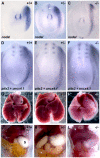Left-right function of dmrt2 genes is not conserved between zebrafish and mouse
- PMID: 21203428
- PMCID: PMC3010978
- DOI: 10.1371/journal.pone.0014438
Left-right function of dmrt2 genes is not conserved between zebrafish and mouse
Abstract
Background: Members of the Dmrt family, generally associated with sex determination, were shown to be involved in several other functions during embryonic development. Dmrt2 has been studied in the context of zebrafish development where, due to a duplication event, two paralog genes dmrt2a and dmrt2b are present. Both zebrafish dmrt2a/terra and dmrt2b are important to regulate left-right patterning in the lateral plate mesoderm. In addition, dmrt2a/terra is necessary for symmetric somite formation while dmrt2b regulates somite differentiation impacting on slow muscle development. One dmrt2 gene is also expressed in the mouse embryo, where it is necessary for somite differentiation but with an impact on axial skeleton development. However, nothing was known about its role during left-right patterning in the lateral plate mesoderm or in the symmetric synchronization of somite formation.
Methodology/principal findings: Using a dmrt2 mutant mouse line, we show that this gene is not involved in symmetric somite formation and does not regulate the laterality pathway that controls left-right asymmetric organ positioning. We reveal that dmrt2a/terra is present in the zebrafish laterality organ, the Kupffer's vesicle, while its homologue is excluded from the mouse equivalent structure, the node. On the basis of evolutionary sub-functionalization and neo-functionalization theories we discuss this absence of functional conservation.
Conclusions/significance: Our results show that the role of dmrt2 gene is not conserved during zebrafish and mouse embryonic development.
Conflict of interest statement
Figures



References
-
- Lourenço R, Saúde L. Symmetry OUT, Asymmetry IN. Symmetry. 2010;2:1033–1054.
-
- Dequéant ML, Pourquié O. Segmental patterning of the vertebrate embryonic axis. Nat Rev Genet. 2008;9:370–382. - PubMed
-
- Cooke J, Zeeman EC. A clock and wavefront model for control of the number of repeated structures during animal morphogenesis. J Theor Biol. 1976;58:455–476. - PubMed
-
- Dequéant ML, Glynn E, Gaudenz K, Wahl M, Chen J, et al. A complex oscillating network of signaling genes underlies the mouse segmentation clock. Science. 2006;314:1595–1598. - PubMed
-
- Dubrulle J, McGrew MJ, Pourquié O. FGF signaling controls somite boundary position and regulates segmentation clock control of spatiotemporal Hox gene activation. Cell. 2001;106:219–232. - PubMed
Publication types
MeSH terms
Substances
LinkOut - more resources
Full Text Sources
Molecular Biology Databases

